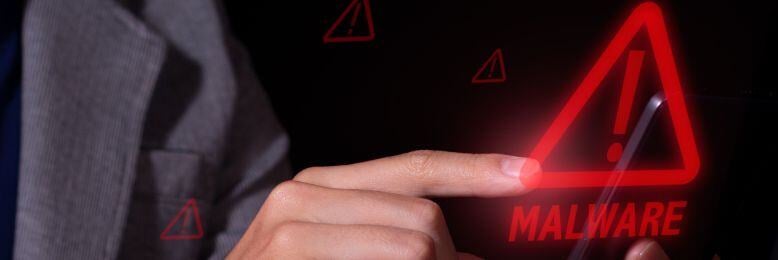Types of Fileless Malware
Fileless malware can be categorized based on its behavior and attack techniques:
1. Memory-Only Malware
This type exploits applications already installed on the computer or runs directly in the system’s RAM. It hijacks those legitimate processes to inject malicious code into your system’s memory.
To give you a better idea of how that looks, imagine opening a web browser and unwittingly executing the malicious code. It leaves no trace on the hard drive and disappears once the device is rebooted. That may sound innocuous, but don’t be fooled. It can cause significant damage or data loss during its active period. It can capture keystrokes, steal passwords, or redirect users to malicious sites, all without creating or altering files on the hard drive.
2. Registry-Based Malware
Instead of files, this type uses the Windows Registry to execute malicious code. It will embed itself in the registry and persist even after rebooting the system. The malware will then write a script into the registry that is executed every time the computer starts. Once it does, it can download more malicious payloads or enable unauthorized remote access.
3. Script-Based Malware
This malware performs its malicious activities by running scripts that appear harmless. It uses common scripting languages that are part of standard operating systems, like PowerShell or JavaScript. It’s usually delivered through a phishing email. Once a user clicks the malicious link, the script will run and reach out to an external server. It will then download and execute further malicious commands directly in the system’s memory.
Risks Posed by Fileless Malware
The risks associated with fileless malware are considerable due to how difficult it is to detect and remove.
1. Evasion of Detection
Traditional antivirus software scans files and directories for known threats. However, fileless malware leaves no files to scan, allowing it to operate undetected.
2. High Success Rate
Fileless malware leverages trusted system tools and processes. Because of that, it typically encounters fewer barriers to execution. That makes it more likely to succeed in its objectives.
3. Persistence and Stealth
Some fileless malware can embed malicious code in the system registry or scheduling tasks. That allows them to persist and remain active even after the system restarts.
4. Potential for Significant Damage
Fileless malware can perform a variety of harmful actions. They can steal sensitive information or install even more malicious payloads into your system. That can compromise personal, financial, or business data.

Practical Steps to Prevent Fileless Malware
Here are the best ways to protect yourself from fileless malware:
1. Update and Patch Regularly
Ensure that your systems and applications are up to date with the latest patches and updates. These updates can fix vulnerabilities that could be exploited by malware. That closes security gaps, making it harder for fileless malware to find a foothold.
2. Enhance Email Security
Phishing emails are one of the most common entry points for fileless malware. That’s why it’s vital to strengthen your email security. Use tools that scan and filter emails for suspicious links and attachments. In addition, educate yourself and your colleagues about the dangers of unsolicited emails. Teach them the importance of not clicking on unknown links or downloading attachments from untrusted sources.
3. Utilize Behavior-based Detection Tools
Fileless malware does not leave typical malware footprints. That’s why it’s better to use security solutions that detect suspicious behavior instead. These tools monitor the system for unusual activities, such as unexpected scripts or unusually high CPU usage. Those might indicate the presence of malware operating in your system’s memory.
4. Restrict Administrative Privileges
Limit the use of administrative privileges on your computer. Fileless malware often needs administrative access to exploit system tools effectively. If you restrict these privileges, you can reduce the malware’s ability to execute its activities even if it does manage to penetrate your system.
5. Harden Your Endpoints
Strengthen the security of your endpoints - the devices that connect to your network like computers and smartphones. Employ application whitelisting, which allows only pre-approved programs to run. That can prevent unauthorized use of system utilities by fileless malware. Additionally, consider disabling scripts and macros in applications where they are not necessary.
6. Get Help from Experts
Some MSPs offer managed cybersecurity services that can secure your entire IT environment. They can help you implement every item on this list to prevent and mitigate fileless malware attacks. Not to mention, they can also offer security information and event management (SIEM) solutions, which help in early detection and prevention.

Need Help Protecting Your Business from Fileless Malware?
The stealthy nature of fileless malware makes it a difficult challenge in the realm of cybersecurity. However, by implementing the practical steps covered in this article, you can mitigate the risk of a fileless malware infection.
Remember that you don’t need to take on the challenge of fileless malware alone. If you need help, our team at ITS is ready to provide support. Our ITS Secure package offers advanced cybersecurity solutions, including SIEM solutions that can help you prevent all kinds of attacks, even the ones that can evade traditional detection methods. Schedule a meeting with our experts to get started, or read through our Learning Center resources:
Topics:
%20-%202024-11-01T152130.513.jpg)
